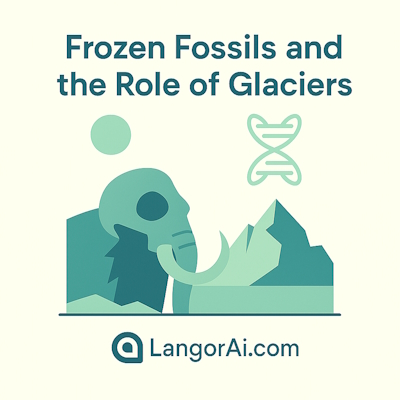
IELTS Reading Practice Test – Passage 1
Frozen Fossils and the Role of Glaciers in Preserving Ancient DNA
Across the Arctic and high-altitude mountain regions, glaciers have long been associated with loss and destruction, as they grind landscapes into fine sediment and reshape valleys. However, in recent decades, scientists have realized that glaciers can also be extraordinary agents of preservation. Under the right conditions, ice can act as a natural deep-freezer, protecting the remains of plants, animals, and even microorganisms that lived tens of thousands of years ago. These frozen fossils have become an invaluable resource in the study of ancient ecosystems and evolutionary history.
DNA, the molecular blueprint of life, degrades rapidly under normal environmental conditions. Heat, oxygen, and microbial activity accelerate its breakdown, often leaving fossils only as mineralized shapes rather than biological records. In contrast, ice suppresses decomposition by isolating organic matter from both oxygen and bacteria. When temperatures remain consistently below freezing, DNA may survive for astonishingly long periods. Researchers have successfully extracted genetic sequences from the remains of mammoths, woolly rhinoceroses, and ancient wolves preserved in permafrost, some dating back more than 40,000 years.
However, not all frozen environments preserve remains equally well. Glaciers are dynamic systems; they move, fracture, melt, and refreeze. Ice near the surface is exposed to sunlight and seasonal temperature fluctuations, which can damage delicate biological tissues. The most promising fossils are found deep within stable permafrost or in ice patches that remain relatively undisturbed. These settings can trap organisms quickly, sometimes freezing them so rapidly that even stomach contents and fur patterns remain intact.
One remarkable discovery occurred in Siberia in 2018, when researchers uncovered the body of a prehistoric wolf pup preserved with its muscles, teeth, and internal organs in excellent condition. Genetic analysis revealed details about ancient wolf populations and their relationship to the ancestors of modern dogs. Such findings help scientists trace how species adapted to changing climates, developed hunting strategies, and migrated across continents.
The scientific significance of frozen fossils extends beyond animals. Plant remains found in ice layers offer clues about ancient climate patterns. Pollen grains, for instance, are highly durable and can indicate which species dominated certain landscapes at particular times. When combined with ice-core data—layers of ice that accumulate annually and trap small amounts of atmospheric gas—researchers can reconstruct long-term fluctuations in temperature and greenhouse gas concentrations.
Despite the value of these discoveries, they are at risk. Rising global temperatures are causing glaciers and permafrost to melt at unprecedented rates. As ice retreats, preserved remains become exposed to the air. While this leads to exciting opportunities for new discoveries, it also means that fossils can deteriorate quickly once thawed. Some scientists argue that excavation teams should be deployed rapidly in newly exposed areas, while others caution that hasty retrieval may damage fragile remains.
Furthermore, ethical debates have emerged regarding the handling of ancient DNA. Some researchers hope to use preserved genomes to resurrect extinct species through selective breeding or genetic engineering. Critics warn that such efforts may distract from conserving endangered species currently at risk. The focus, they argue, should be on prevention, not resurrection.
Yet, even without revival projects, frozen fossils—and the DNA they contain—remain vital to understanding life’s past. They reveal how species adapt, migrate, and evolve under environmental pressure. As climate change accelerates, the need to document and study these ancient archives becomes increasingly urgent.
Questions 1–7 (True / False / Not Given)
Questions 8–12 (Matching Information)
Match each statement with the paragraph (A–H):
A = Paragraph 1
B = Paragraph 2
C = Paragraph 3
D = Paragraph 4
E = Paragraph 5
F = Paragraph 6
G = Paragraph 7
H = Paragraph 8
Questions 13–15 (ONE WORD ONLY)
Answer Key & Explanations
1 → FALSE – Paragraph 1 states glaciers destroy but also preserve.
2 → TRUE – Heat and oxygen accelerate DNA breakdown.
3 → NOT GIVEN – Some glaciers preserve well, others don’t, but it does not say “all or none.”
4 → TRUE – The Siberian wolf pup had organs preserved.
5 → FALSE – Pollen provides climate insights.
6 → FALSE – Melting exposes and damages remains.
7 → TRUE – Paragraph 6 mentions rapid excavation.
8 → C – Paragraph 3 discusses varying conditions.
9 → D – The wolf pup study revealed evolutionary patterns.
10 → D – Same paragraph describes the discovery.
11 → F – Paragraph 6 warns against quick retrieval.
12 → G – Paragraph 7 covers ethical debates.
13 → ice
14 → pollen
15 → melting
